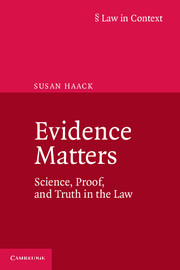Book contents
- Frontmatter
- Epigraph
- Contents
- Acknowledgments
- Introduction: A Pragmatist Perspective on Science, Proof, and Truth in the Law
- 1 Epistemology and the Law of Evidence
- 2 Epistemology Legalized
- 3 Legal Probabilism
- 4 Irreconcilable Differences? The Troubled Marriage of Science and Law
- 5 Trial and Error
- 6 Federal Philosophy of Science
- 7 Peer Review and Publication
- 8 What’s Wrong with Litigation-Driven Science?
- 9 Proving Causation
- 10 Correlation and Causation
- 11 Risky Business
- 12 Nothing Fancy
- Cases Cited
- Statutes, etc., Cited
- Bibliography
- Glossary
- Index
7 - Peer Review and Publication
Lessons for Lawyers
Published online by Cambridge University Press: 05 August 2014
- Frontmatter
- Epigraph
- Contents
- Acknowledgments
- Introduction: A Pragmatist Perspective on Science, Proof, and Truth in the Law
- 1 Epistemology and the Law of Evidence
- 2 Epistemology Legalized
- 3 Legal Probabilism
- 4 Irreconcilable Differences? The Troubled Marriage of Science and Law
- 5 Trial and Error
- 6 Federal Philosophy of Science
- 7 Peer Review and Publication
- 8 What’s Wrong with Litigation-Driven Science?
- 9 Proving Causation
- 10 Correlation and Causation
- 11 Risky Business
- 12 Nothing Fancy
- Cases Cited
- Statutes, etc., Cited
- Bibliography
- Glossary
- Index
Summary
[A] pertinent consideration [in determining whether a theory or technique is scientific knowledge that will assist the trier of fact] is whether the theory or technique has been subjected to peer review and publication.
–Daubert v. Merrell Dow Pharmaceuticals, Inc. (1993)The phrase “peer review” connotes the evaluation (“review”) of scientific or other scholarly work by others presumed to have expertise in the relevant field (“peers”). Specifically, and most to the present purpose, it refers to the evaluation of submitted manuscripts to determine what work is published in professional journals and what books are published by academic presses (in which context it is also called “refereeing,” “editorial peer review,” or “pre-publication peer review”). Occasionally, however, the phrase is used in a much broader sense, to cover the whole long-run history of the scrutiny of a scientist’s work within the scientific community, and of others’ efforts to build on it, a long-run process of which peer review in the narrower sense is only a small part.
These two conceptions of peer review, the narrow and the broad, both came into play in the arguments over the admissibility of the plaintiffs’ expert testimony in Daubert. In 1989, granting Merrell Dow’s motion for summary judgment on the grounds that the Dauberts’ proffered causation evidence was inadmissible, the district court had stressed that “none of the published studies show a statistically significant association between the use of Bendectin and birth defects”; and affirming this decision in 1991, observing that “no published epidemiological study had demonstrated a statistically significant association between Bendectin and birth defects,” and that “the normal peer[-]review process … is one of the hallmarks of reliable scientific investigation,” Judge Kozinski also took peer-reviewed publication to be a key factor.
- Type
- Chapter
- Information
- Evidence MattersScience, Proof, and Truth in the Law, pp. 156 - 179Publisher: Cambridge University PressPrint publication year: 2014



